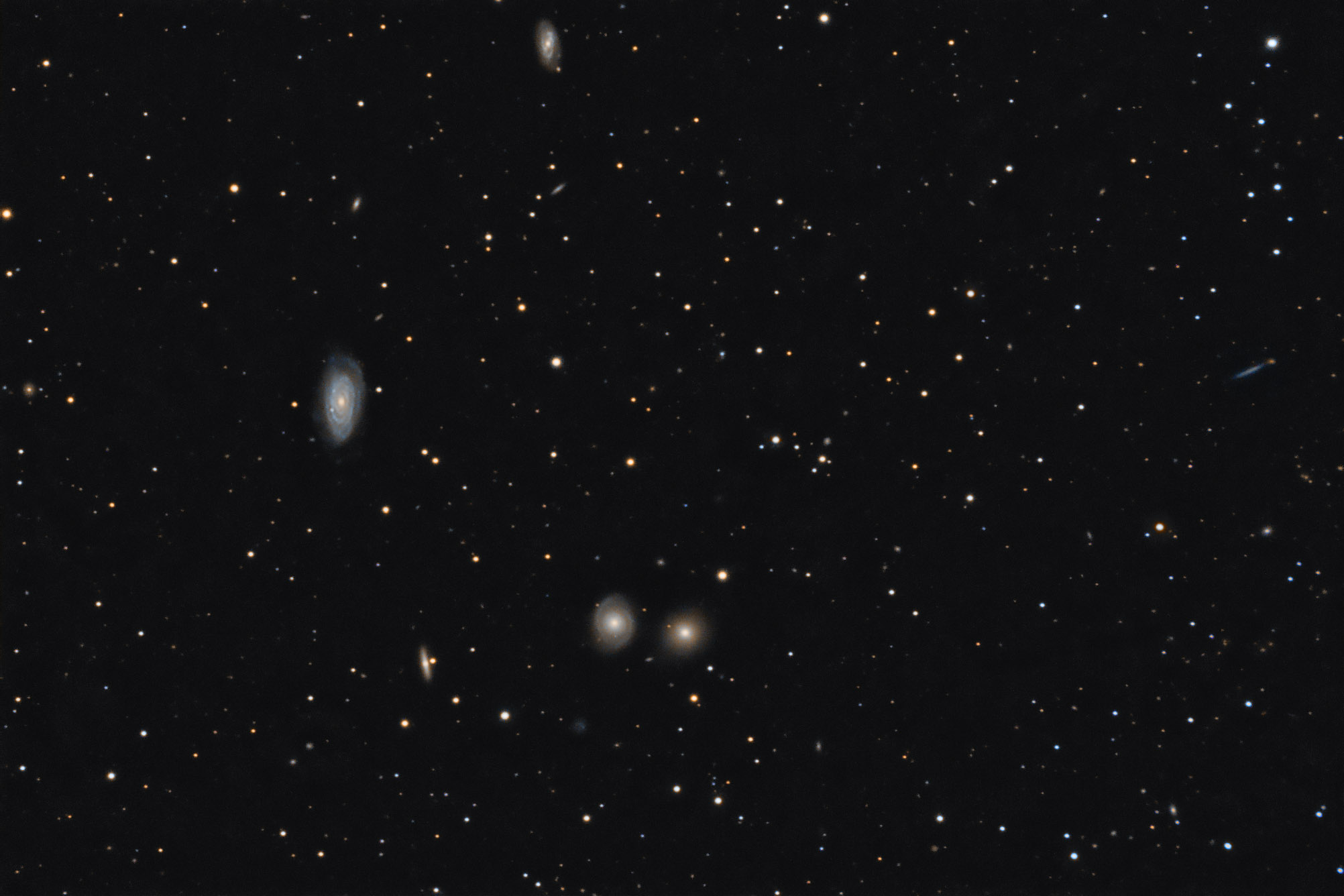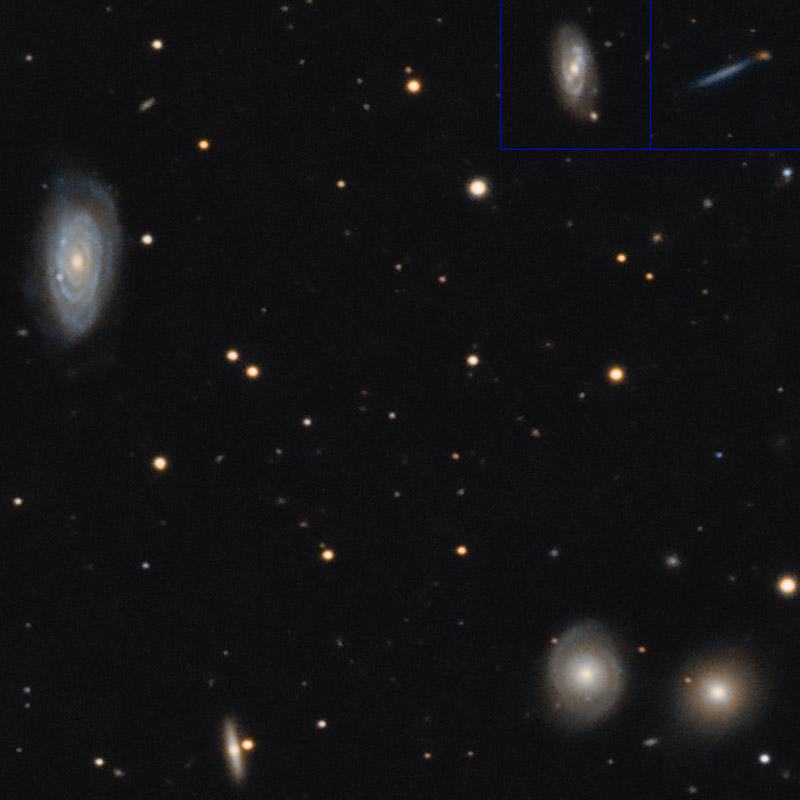Object name: NGC7778Designation(s): NGC7778, NGC7779, NGC7780, NGC7781, NGC7782, WBL727, This NGC group in Pisces under the Great Square of Pegasus is located about 220 million light-years distant. All but NGC 7780 are members of the WBL 727 galaxy group. All 5 are members of the USGC U860 group. That group has two other members out of my frame, one to the south the other to the northwest.
I was only trying for the WBL 727 group so the rest are just lucky to make it into the frame. Especially FGC 2548 which was also on my to-do list but I'd not realized could be part of this image. I sometimes get lucky. It is better known as LEDA 091829. I was interested in the little red galaxy off its west ansa. Unfortunately, I can't find anything on it as it isn't in either NED or SIMBAD.
NGC 7782 is the only one large enough to show much detail. Notice how its spiral arms aren't connected to anything like a core. Also, it seems to have faint outer plumes regions to the north, south and east that may indicate it is still digesting another group member it ate in the past. In any case, it is very large. I get a size of 175,000 light-years including the plumes. Ignoring them it is still 115,000 light-years in size.
NGC 7778 is listed as an elliptical though one paper says it shows hints of spiral structure. NGC 7779 is a very fuzzy spiral, NGC 7781 has no detail at all and may be an S0 to my eye. It is the smallest member of the group at 55,000 light-years. NGC 7780 has some interesting spiral arms. Two may come from the core while two arcs appear to be bright extensions of these arms after they faded away. The southern one longer than the northern. It seems rather odd to me but didn't get a peculiar label.
NGC 7778, NGC 7779 and NGC 7782 were discovered by William Herschel on November 12, 1784.
NGC 7780 was found by Édouard Stephan on October 18, 1881. NGC 7781 was discovered by John Herschel on August 16, 1830.
There are a couple of distant galaxy clusters in the image. Neither have a cD galaxy so I've drawn a line to the center position which is rather vague in NED. One has an estimated distance, how that was estimated I have no idea as NED doesn't say. The Zwicky cluster has no distance at all. It is quite large and may include the other cluster. Data on both is too vague to even hazard a guess. Another galaxy I hoped to find something on is the blue smudge of a low surface brightness galaxy southeast of NGC 7779. NED shows it only as an Ultraviolet Source found by the GALEX UV satellite. Apparently, nothing else has even noticed it.
This field is near the Zone of Avoidance so poorly studied. I was surprised I found as much as I didn't. Normally I don't include names that are just coordinates, just listing them as G for galaxy, Q for quasar GC for galaxy cluster etc. This is because their labels get huge and often overlap. This field had no such issue and with little else, I broke my rule and included such identifications even when no redshift data was available. Don't expect to see this very often.
NGC 7778, NGC 7779 and NGC 7782 were discovered by William Herschel on November 12, 1784. NGC 7780 was discovered by Édouard Stephan on October 1881 and NGC 7781 was discovered by John Herschel on August 16, 1830.
14" LX200R @ f/10, L=4x10' RGB=2x10' STL-11000XM, Paramount ME Related Designation(s):2MASS J23531966+0752154, 2MASS J23532678+0752323, 2MASS J23533216+0807052, 2MASS J23534600+0751378, 2MASS J23535388+0758139, 2MASX J23531967+0752152, 2MASX J23532680+0752322, 2MASX J23533218+0807052, 2MASX J23534595+0751377, 2MASX J23535389+0758138, 2MFGC 17940, AKARI J2353543+075759, ARK 586, CGCG 2350.7+0736, CGCG 2350.9+0736, CGCG 2351.0+0750, CGCG 2351.2+0735, CGCG 2351.3+0742, CGCG 407-069, CGCG 407-070, CGCG 407-071, CGCG 407-072, CGCG 407-073, GALEXASC J235319.78+075217.3 , GALEXASC J235332.19+080707.5 , GALEXASC J235345.79+075138.8 , HDCE 1258 NED001, HDCE 1258 NED002, HDCE 1258 NED003, HDCE 1258 NED004, HDCE 1258 NED005, IRAS 23509+0750, IRAS 23513+0741, IRAS F23509+0750, IRAS F23513+0741, LDCE 1600 NED001, LDCE 1600 NED002, LDCE 1600 NED003, LDCE 1600 NED004, LDCE 1600 NED005, MCG +01-60-043, MCG +01-60-045, MCG +01-60-046, MCG +01-60-047, MCG +01-60-048, NGC 7778, NGC 7779, NGC 7780, NGC 7781, NGC 7782, NGC7778, NGC7779, NGC7780, NGC7781, NGC7782, NSA 152860, NSA 152862, NSA 152865, NSA 152870, NSA 152873, PCC S49-139, PGC 072756, PGC 072770, PGC 072775, PGC 072785, PGC 072788, SDSS J235332.15+080705.0, SDSS J235332.15+080705.1, SDSS J235353.88+075814.1, UGC 12827, UGC 12831, UGC 12833, UGC 12834, USGC U860 NED01, USGC U860 NED02, USGC U860 NED03, USGC U860 NED04, USGC U860 NED05, UZC J235319.6+075215, UZC J235326.8+075232, UZC J235332.2+080705, UZC J235346.0+075138, UZC J235354.0+075814, v2MCG 85:[DMP2012] 1, v2MCG 85:[DMP2012] 2, v2MCG 85:[DMP2012] 3, v2MCG 85:[DMP2012] 4, v2MCG 85:[DMP2012] 5, WBL 727, WBL 727-001, WBL 727-002, WBL 727-003, WBL 727-004, WBL727, [M98j] 267, [M98j] 267 NED01, [M98j] 267 NED02, [M98j] 267 NED03, | | 

